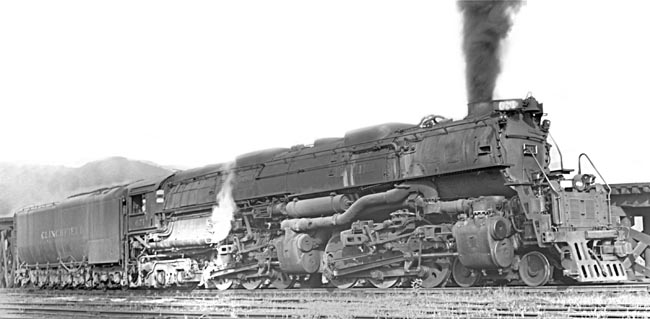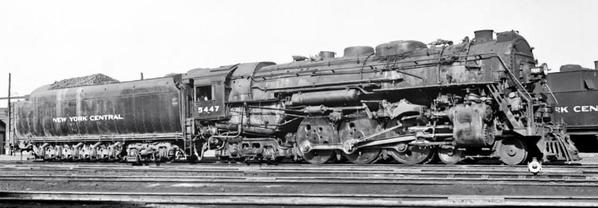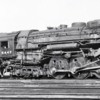The NYC PT tender looks like it had the same "wheel arrangement" as UP 844, 3985, and 4014's tenders. Central's scooped water, UP's did not. Was there an advantage to this sort of wheel arrangement for the tenders?
Replies sorted oldest to newest
They could hold more weight in water or fuel or both and distribute that weight over more axles to maintain lower axle loadings. The New York Central tenders, which utilized water scoops for taking water on the fly, had very large coal bunkers to enable Harmon, NY to Chicago, IL or Harmon, NY to Mattoon, IN (St. Louis Line) with one stop for coal at Wayneport, NY near Rochester. Another advantage of the NYC tenders was their long rear overhang and shorter relative wheelbase allowed the locomotives equipped with them to be turned on 100 foot turntables.
The UP tenders were more conventionally balanced between coal bunker and water cistern compartments.
Other locomotives also using "centipede" or "pedestal" tenders included:
- Boston & Maine Mountains
- Denver & Rio Grande L-97 Challengers
- Duluth, Missabe & Iron Range Yellowstones
- Clinchfield E-2, E-3 Challengers
- Great Northern Z-6 Challengers
- Northern Pacific A-5 Northerns
- Northern Pacific Z-7 and Z-8 Challengers
- Spokane, Portland & Seattle Z-6 Challengers
(List copied from steamlocomotive.com)
I don't believe the Clinchfield E-2 Challengers actually had centipede tenders. The E-3s did. They were second-hand purchases from the Rio Grande, their class L-97, which were copies of the Union Pacific 3900 class.
One disadvantage of this style of tender was their tendency to derail on tightly curved or poorly maintained track.
NYC used this design for several reasons:
1) With one more axle, it could carry more coal and water than a 12 wheel tender
2) With a rigid 5 axle wheelbase that was cast integral with the frame, it saved weight vs a similar size tender with swivel trucks and this weight savings translated into an increase in weight efficiency vs payload. The rigid wheelbase might have resulted in better tracking and ride at high speeds vs a swivel truck tender
3) The NYC design used 41"diameter wheels. Late Mohawkswivel truck tenders used 41" wheels while Hudsons were 36". So wheel life was much greater. (UP tenders are 42" I believe.)
4) With overflow control, water could be scooped from track pans at 80 mph. Previous 12 wheel tenders with water scoops were limited to 45 mph
5) In NYC parlance, "PT" means passenger tender. So it was a high speed design on NYC and was used mainly in passenger service, except at the end of steam when Hudsons and Niagaras were at times used for freight. Note that the Centipede tenders used by UPRR were on both passenger and freight engines and UP power carried much more water and less coal (or oil). UP did not use track pans.
6) When the Niagaras were built, the use of this tender resulted in a loco and tender wheelbase of 97'-2-1/2", so the engine would fit on a 100 ft turntable, which were available at several locations on the NYC main line.
Nick Chillianis posted:They could hold more weight in water or fuel or both and distribute that weight over more axles to maintain lower axle loadings. The New York Central tenders, which utilized water scoops for taking water on the fly, had very large coal bunkers to enable Harmon, NY to Chicago, IL or Harmon, NY to Mattoon, IN (St. Louis Line) with one stop for coal at Wayneport, NY near Rochester. Another advantage of the NYC tenders was their long rear overhang and shorter relative wheelbase allowed the locomotives equipped with them to be turned on 100 foot turntables.
The UP tenders were more conventionally balanced between coal bunker and water cistern compartments.
Other locomotives also using "centipede" or "pedestal" tenders included:
- Boston & Maine Mountains
- Denver & Rio Grande L-97 Challengers
- Duluth, Missabe & Iron Range Yellowstones
- Clinchfield E-2, E-3 Challengers
- Great Northern Z-6 Challengers
- Northern Pacific A-5 Northerns
- Northern Pacific Z-7 and Z-8 Challengers
- Spokane, Portland & Seattle Z-6 Challengers
(List copied from steamlocomotive.com)
I don't believe the Clinchfield E-2 Challengers actually had centipede tenders. The E-3s did. They were second-hand purchases from the Rio Grande, their class L-97, which were copies of the Union Pacific 3900 class.
One disadvantage of this style of tender was their tendency to derail on tightly curved or poorly maintained track.
A few corrections.
Only the last group of B&M Mountains (and the three L&HR copies) had centipede tenders.
The GN/SP&S Z-6 Challengers had semi-vanderbilt tenders with six wheel trucks.
NP Class A-4 Northerns also had centipede tenders.
Yes, only the Clinchfield E-3 class had centipede tenders (these were ex-Rio Grande L-97 purchased from the War Production board, as Rio Grande didn't want them).
Stuart
"One disadvantage of this style of tender was their tendency to derail on tightly curved or poorly maintained track."
Yes, just like on my layout, traveling through the yard is a white knuckle experience with one thumb hovering over the E stop button...
Stuart posted:Nick Chillianis posted:They could hold more weight in water or fuel or both and distribute that weight over more axles to maintain lower axle loadings. The New York Central tenders, which utilized water scoops for taking water on the fly, had very large coal bunkers to enable Harmon, NY to Chicago, IL or Harmon, NY to Mattoon, IN (St. Louis Line) with one stop for coal at Wayneport, NY near Rochester. Another advantage of the NYC tenders was their long rear overhang and shorter relative wheelbase allowed the locomotives equipped with them to be turned on 100 foot turntables.
The UP tenders were more conventionally balanced between coal bunker and water cistern compartments.
Other locomotives also using "centipede" or "pedestal" tenders included:
- Boston & Maine Mountains
- Denver & Rio Grande L-97 Challengers
- Duluth, Missabe & Iron Range Yellowstones
- Clinchfield E-2, E-3 Challengers
- Great Northern Z-6 Challengers
- Northern Pacific A-5 Northerns
- Northern Pacific Z-7 and Z-8 Challengers
- Spokane, Portland & Seattle Z-6 Challengers
(List copied from steamlocomotive.com)
I don't believe the Clinchfield E-2 Challengers actually had centipede tenders. The E-3s did. They were second-hand purchases from the Rio Grande, their class L-97, which were copies of the Union Pacific 3900 class.
One disadvantage of this style of tender was their tendency to derail on tightly curved or poorly maintained track.
A few corrections.
Only the last group of B&M Mountains (and the three L&HR copies) had centipede tenders.
The GN/SP&S Z-6 Challengers had semi-vanderbilt tenders with six wheel trucks.
NP Class A-4 Northerns also had centipede tenders.
Yes, only the Clinchfield E-3 class had centipede tenders (these were ex-Rio Grande L-97 purchased from the War Production board, as Rio Grande didn't want them).
Stuart
As I said Stuart, I did a cut and paste from steamlocomotive.com. They snookered me. ![]()
Nick Chillianis wrote:
I don't believe the Clinchfield E-2 Challengers actually had centipede tenders. The E-3s did. They were second-hand purchases from the Rio Grande, their class L-97, which were copies of the Union Pacific 3900 class.
The Rio Grande L-97 was not a copy of the UP 3900's, they were UP locomotives, that the War Production Board(WPB) diverted from a UP order, when the Rio Grande wanted to order locomotives of their own design, and were refused. These were the same locomotives that the Clinchfield later acquired after the war when the Rio Grande returned them to the WPB. The Clinchfield , later converted these locomotives to a single stack design, that for reasons maybe Hotwater or Rich can explain, steamed better as single stack, rather than the original UP design two stack design.
Doug
challenger3980 posted:Nick Chillianis wrote:
I don't believe the Clinchfield E-2 Challengers actually had centipede tenders. The E-3s did. They were second-hand purchases from the Rio Grande, their class L-97, which were copies of the Union Pacific 3900 class.
The Rio Grande L-97 was not a copy of the UP 3900's, they were UP locomotives, that the War Production Board(WPB) diverted from a UP order, when the Rio Grande wanted to order locomotives of their own design, and were refused. These were the same locomotives that the Clinchfield later acquired after the war when the Rio Grande returned them to the WPB. The Clinchfield , later converted these locomotives to a single stack design, that for reasons maybe Hotwater or Rich can explain, steamed better as single stack, rather than the original UP design two stack design.
Doug
You are correct. Rio Grande never cared for those ALCO Challengers, preferring their Baldwin-built L-105s. This may have been because of the greater TE of the L-105s as well as the fact that they were equipped with the Le Chatelier Water Brake, a compression braking system which allowed the locomotive's pistons to hold the train back on descending grades similar to diesel-electric dynamic braking.
My guess is that Clinchfield had access to better, higher btu coal than UP did, and the two stack design used by UP was required to properly draft the engine when the coal of lower calorific value was used. And that is a "guess".








